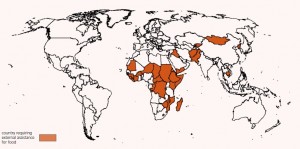In a post over at the Atlantic, Barry Estabrook begins as follows:
Given that current production systems leave nearly one billion people undernourished, the onus should be on the agribusiness industry to prove its model, not the other way around.
Let’s ask ourselves whether organic agriculture can feed the world, shall we? “The way I see it, Barry, this should be a very dynamite show!”
Well Barry, it turns out the agribusiness industry has already proven its model: It has survived the market test for several decades.
If organic is so much better, why is it that the most democratic of all institutions — the market — is not allowing it to win out? Could it be that it’s because organic is more expensive?
(Update: Johanna, a reader, made an excellent point about agricultural subsidies in the comments, which has made me change my mind about the viability of “conventional” agriculture relative to organic if we were to get rid of agricultural subsidies.)
And another thing: the one billion people that go undernourished? Their plight is the result of lack of storage and transportation infrastructures, which both add significant transaction costs to the market price of food and leave many people out of the market altogether, and not because of a lack of food to go around.
Even if we could magically motivate donors to fund storage and transportation infrastructure (because let’s face it Barry, is there anything sexier for donors than to invest in refrigeration technology or roads?) is more expensive food really the answer to chronic undernourishment?

What Grinds My Gears: “Organic Can Feed the World”
In a post over at the Atlantic, Barry Estabrook begins as follows:
Given that current production systems leave nearly one billion people undernourished, the onus should be on the agribusiness industry to prove its model, not the other way around.
Let’s ask ourselves whether organic agriculture can feed the world, shall we? “The way I see it, Barry, this should be a very dynamite show!”
Well Barry, it turns out the agribusiness industry has already proven its model: It has survived the market test for several decades.If organic is so much better, why is it that the most democratic of all institutions — the market — is not allowing it to win out? Could it be that it’s because organic is more expensive?(Update: Johanna, a reader, made an excellent point about agricultural subsidies in the comments, which has made me change my mind about the viability of “conventional” agriculture relative to organic if we were to get rid of agricultural subsidies.)
And another thing: the one billion people that go undernourished? Their plight is the result of lack of storage and transportation infrastructures, which both add significant transaction costs to the market price of food and leave many people out of the market altogether, and not because of a lack of food to go around.
Even if we could magically motivate donors to fund storage and transportation infrastructure (because let’s face it Barry, is there anything sexier for donors than to invest in refrigeration technology or roads?) is more expensive food really the answer to chronic undernourishment?